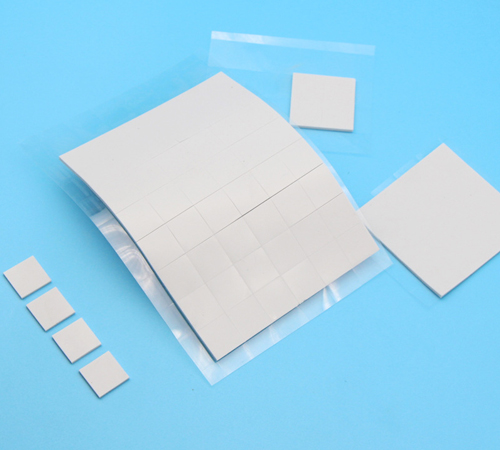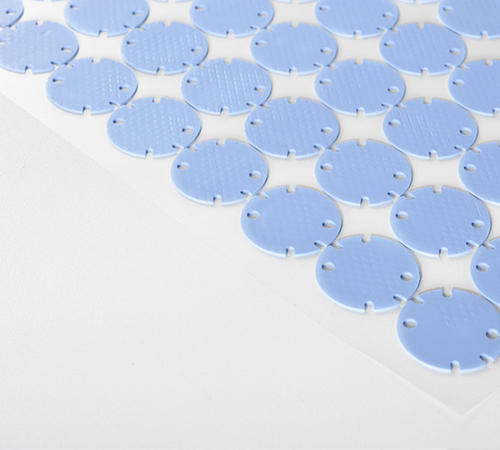Certified by RoHS and REACH, with no silicone oil migration—safe for optical and precision electronics, ensuring a cleaner and safer application.
|
Test Item |
Parameter |
Unit |
Test Standard |
|
Thermal Conductivity |
1.5(±0.2) |
W/m⋅K |
ASTM D5470 |
|
Thermal Resistance |
≤1.5 |
∘C in2/W |
ASTM D5470 |
|
Color |
Gray, Blue, Pink |
- |
Visual |
|
Thickness |
0.3−15 |
mm |
ASTM D374 |
|
Hardness |
35±5 |
Shore C |
ASTM D2240 |
|
Density |
2.6(±0.5) |
g/cc |
ASTM D 792 |
|
Flammability Rating |
V0 |
- |
UL 94 |
|
Operating Temperature |
−50∼160 |
℃ |
IEC 60068-2-14 |
|
Dielectric Breakdown Voltage |
≥6 |
Kv |
ASTM D 149 |
|
Volume Resistivity |
≥108 |
Ω⋅cm |
ASTM D 257 |
NF150-150 is widely applied in multiple sectors thanks to its superior thermal, mechanical, and electrical properties:
Application Industry
Typical Applications
New Energy
1. Power Battery Packs/Modules: Thermal conduction between battery cells and liquid cooling plates or heat dissipation structural components
2. Photovoltaic Inverter (PV Inverter): Thermal conduction between power modules (such as IGBT or MOSFET) and heat sinks
3. Energy Storage System PCS/BMS: Thermal conduction between power devices in energy storage converters and heat sinks
4. Electric Vehicle On-Board Charger (OBC): Heat dissipation for internal high-power components (such as inductors, switches)
5. Wind Power Converter: Heat dissipation for high-power semiconductor devices in inverters and heat sinks
Automotive Electronics
1. ADAS/Autonomous Driving Domain Controller: Thermal conduction between high-performance computing chips (CPU/GPU) and the enclosure/heat sink
2. In-Vehicle Infotainment System (IVI): Heat dissipation for main control chips or backlight modules
3. High-Power DC-DC Converter: Thermal conduction between power components (such as MOSFETs, transformers) and the enclosure
4. LED Car Headlight Module: Thermal conduction between the LED light source and the heat dissipation substrate/lamp body
5. Vehicle Radar/LiDAR Module: Heat dissipation for internal microwave or laser emitting components and the enclosure
Network Communication
1. 5G/6G Communication Base Station: Thermal conduction between RF Power Amplifier (PA) modules and heat sinks
2. Optical Module/Fiber Optic Transceiver: Heat dissipation for internal lasers or high-speed chips and the enclosure
3. Servers/Switches: Thermal conduction between CPU/GPU, high-power memory or solid-state drives and heat sinks
4. Data Center Power Module: Heat dissipation for power devices (IGBT/MOSFET) and heat sinks
5. Routers/Gateway Devices: Heat dissipation for main control chips or wireless RF chips and heat sinks
Industrial Power
1. Industrial PC/PLC Power Supply: Thermal conduction between internal transformers, rectifier bridges or switching tubes and heat sinks
2. High-Power UPS Uninterruptible Power Supply: Heat dissipation for IGBT modules and power devices in battery management units
3. Electric Vehicle Charging Pile: Thermal conduction between power devices (such as IGBT, inductors) in the charging module and heat sinks
4. Rail Transit Power Supply: Heat dissipation for high-power electronic components such as traction inverters
5. Industrial Laser Power Supply: Heat dissipation for power components in laser drive modules
Consumer Electronics
1. Smartphones/Tablets: Thermal conduction between the main chip (SoC), memory module or battery and the mid-frame/graphene film
2. Laptops/Gaming Laptops: Thermal conduction between CPU/GPU chips and heat pipes/vapor chambers
3. OLED/LCD Display Backlight Module: Heat dissipation for drive ICs or light source components
4. TWS Headphone Charging Case: Heat dissipation for wireless charging receiving coils or main control chips
5. High-Performance Solid State Drives (SSD): Thermal conduction between controller chips or flash memory particles and heat sinks
LED Lighting
1. High-Power LED Street Lights: Thermal conduction between COB/high-power LED light sources and heat sinks
2. LED Floodlights/High Bay Lights: Thermal conduction between LED modules and heat dissipation enclosures
3. LED Display Modules: Heat dissipation for drive ICs or power modules and PCB boards/enclosures
4. LED Photography Lights/Studio Lights: Heat dissipation for high-brightness LED chips and heat dissipation modules
5. Automotive LED Headlights: Thermal conduction between LED chips and lamp body heat sinks
Artificial Intelligence
1. AI Servers/Accelerator Cards: Thermal conduction between high-performance AI chips (ASIC/GPU/FPGA) and liquid/air coolers
2. Edge Computing Devices/Industrial PCs: Heat dissipation for edge AI chips (such as NPU) and enclosures/heat sinks
3. AI Smart Robots: Heat dissipation for heating elements in main control boards and motor drive modules
4. Drone Flight Control System: Thermal conduction between the main control chip, power management unit, and the enclosure
5. VR/AR Head-Mounted Devices: Heat dissipation for internal main control chips, display driver chips and heat sinks
 CN >
CN >



